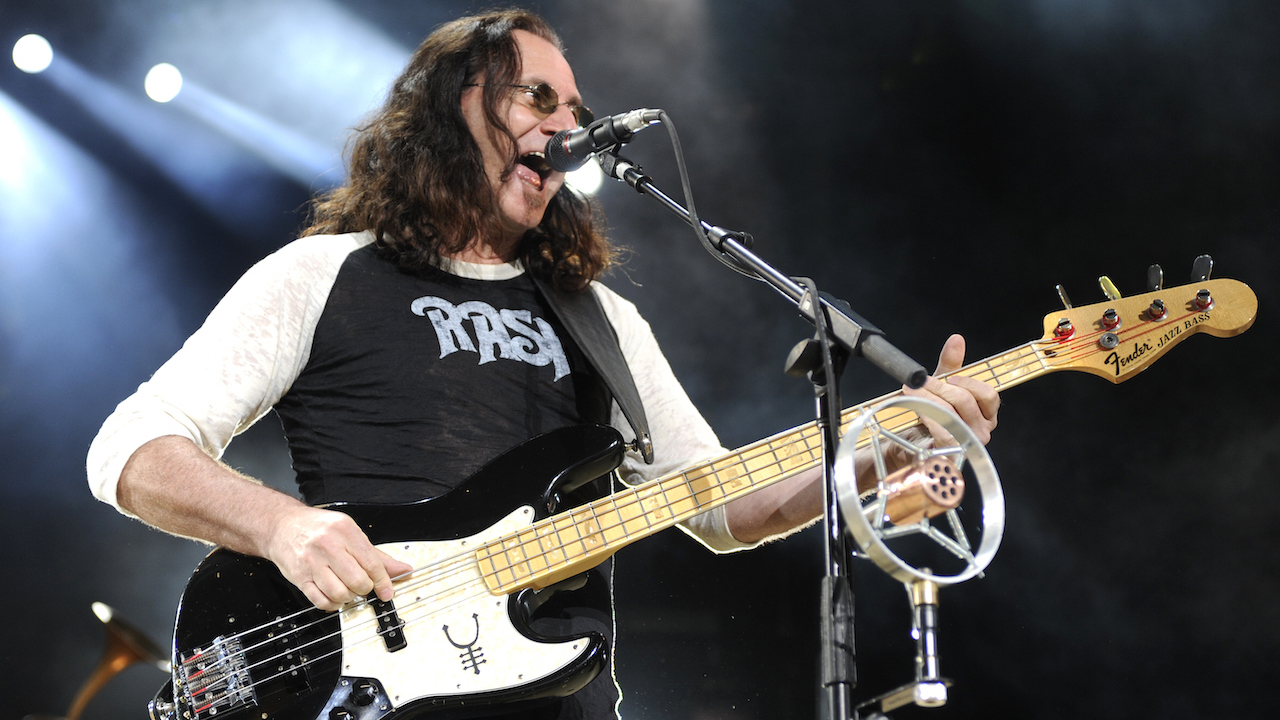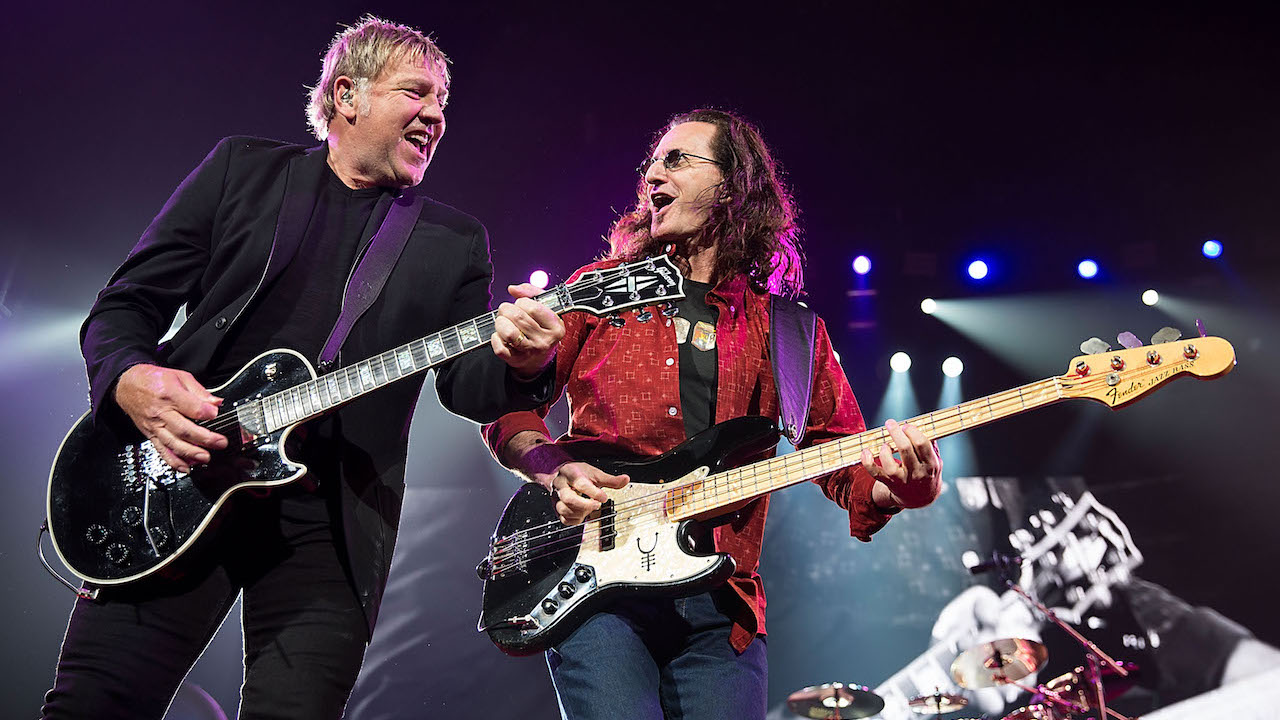“You bassists who think your bass isn’t loud enough, you’re right! I always want my bass louder in the mix”: How Geddy Lee found his sound with Rush
Geddy Lee used distortion to “knit together” his live sound with Canada’s pioneering power trio

Bass guitar heroes don’t get much bigger than Geddy Lee. Although he ‘crossed the floor’ to Fender more years ago than even he cares to remember, the metallic clang of his Rickenbacker 4001 has pierced the minds of millions.
For Lee, laying down the basslines for Rush has certainly had its ups and downs. “I’m a fairly obnoxious bass player,” he told BP in 2007. “I don’t think my bass playing style is very typical. I always want my bass louder in the mix. You bassists who think your bass isn’t loud enough, you’re right!”
In true prog style, Lee likes to dabble with effects in order to shape his iconic bass guitar tone: “If you listen to my bass on its own, it sounds really ratty and nasty, but the right kind of distortion helps knit the overall sound together. I’m very intrusive, but we are all our own worst critics, right?”
For any band, working in the studio and making records can be an intense and emotional experience, and for Lee it’s the live arena where he feels he can stretch out more as a bass player. “Using distortion live is key for me. When you're in the studio using computers to write music – fitting everything nice and tight on that graph – it can be too mathematical and clean. That doesn’t necessarily make for a great performance.”
The following interview is from the August 2007 issue of Bass Player, which followed the release of Snakes & Arrows, the first new music from Rush since 2002’s Vapor Trails.
How do you and Alex Lifeson typically write together?
“Normally we just sit down and start playing. When I feel there is something connecting, I hit record. And as long as we’re having fun and we’re into something, I let it run. On a break I’ll start listening through what we’ve done, isolating bits I think are worth developing. Alex and I have a great relationship – he knows I enjoy doing all the structural arrangement, so he lets me run with it.”

How did you go about writing the new material for Snakes & Arrows?
Get The Pick Newsletter
All the latest guitar news, interviews, lessons, reviews, deals and more, direct to your inbox!
“Alex and I would get together about three days a week. We sat down and did a lot of talking about how to approach it. We used to write a lot while we were touring, using acoustic instruments in hotel rooms or the back of a station wagon. That’s a great way to write for a couple of reasons. It’s much more demanding to play an acoustic instrument, so Alex got his fingers in incredible shape in a very short period of time. Also, if you are writing on an acoustic guitar, it’s clearer what works and what doesn’t work – you can’t be fooled by the technology. Sometimes the sexiness of the sound can trick you into believing a part is great, when you’re really just working with a cool sound.”
How does that relate to bass?
“Bass is pretty naked all the time, though you can fuzz it out with effects. For me the bass is mostly a device to come up with patterns and harmonies to support the vocal melody. When we were writing, I’d play a lot of chords on bass, treating it like a guitar.”
Do you and Alex program your own drum beats?
“Yeah, we have fun doing that. Alex follows his off-the-wall instincts for drum patterns – he has a reputation for being the world’s wildest electric drummer! Neil thinks Alex is a genius on drums, so he borrows some of those ideas to get going. When we finish a sketch we give it to Neil both with and without drums so he can work out his own ideas.”

Do your parts change once it shifts to live drums?
"They have to, because it feels very stiff when I’m playing bass with a drum machine. Often I cut-and-paste those original sketches and put together a new arrangement. Once the real drums are there, I’ll talk to Neil about his drum patterns and adjust things in my part. The end result has more of a realistic heartbeat, rather than a metronomic feel. In Neil’s online diary about making Snakes & Arrows, he says that he sees himself as more of a composer than an improviser.”
Where do you see yourself along those lines?
“The two of us are similar – I guess that’s rubbed off after all these years. I’m very much a beast of structure, while Alex is very spontaneous. We make a good team because of that. I’m much more linear then he is. He’s a crazy Serb! I think that’s why we have been such good friends all these years. Neil and I can read each other’s minds rhythmically, which can be both good and bad.”
Having tracked bass and vocals independently, have you run into trouble performing both parts simultaneously onstage?
“There’s only been one song that’s been a real struggle for me to separate bass and voice – The Way the Wind Blows. The vocal is legato over a very active rhythm section, so I have to learn some independence. The bass has to be subservient to the vocal; it’s all subservient to what sounds best for my voice. The hardest thing is to capture the dynamic nuances. The Way the Wind Blows is a difficult song live because it goes from a real rocking verse part into what we call the anti-chorus – most choruses get louder, but sometimes ours get softer. That’s a hard dynamic to work with a live three-piece band. A recording studio is better suited for that kind of delicate playing.”
Was Malignant Narcissism one of the songs born out of jamming?
“Actually it was way more spontaneous. That song was the very last thing we did we on the record; we wrote it in the studio after we were pretty much done with everything. I was in the middle of doing vocal tracks when a friend visited and told me about Fender’s Jaco Pastorius Tribute Bass. I checked it out online and thought it looked cool, so I asked Fender to send me one. I’d just plink on it in between vocal takes. It’s a glorious bass to play – it just feels special.”
“I was jamming with it one day, and unbeknownst to me, Nick was recording the jam. At one point I was playing a little riff, and he came in and went, 'Dude, that’s a song – you’ve got to make a song out of that!' Neil happened to be there – we had finished his drums by then and torn down his regular kit, but we had left a little four-piece kit set up for us to jam on. We threw the song together with just bass and drums, playing live. Later, Alex came back and put his parts down. It took just a couple of days to throw together.”
Have you played much fretless bass?
“Not successfully. But I’ve discovered that when you play fast, people can’t tell if you’re in tune or not. When the notes pass quickly, you can get away with lousy intonation. I asked Fender to make a fretted version of the Jaco Pastorius bass, so if I’m having trouble with intonation, I can always play that one. But that’s a bit of a cop out. After all, I can’t make a big deal out of playing fretless if I can’t do it live – the shame will be too much for me to bear!”
How did The Main Monkey Business come to be?
“That was a pet project of mine. Once we had most of the material written, we did this big monster jam. We had a ton of great parts, and I spent four days trying to create the most self-indulgent piece I could think of. I changed parts when I felt like it, and I put it together in a really selfish way, not considering whether someone else would be able to understand it or not. I had a lot fun chopping up Alex’s guitar parts.”
How would you characterize your own bass playing?
“I was born into the Jack Bruce, Chris Squire, Jack Casady world – those guys all pushed the melodic side of bass playing. That’s how I viewed my role: not just to lay down the beat, but to add melody and some edge – especially in a three-piece – to fill up the sound. That’s why I often let my open strings ring out; I try to be a bass player and guitar player at the same time. I guess my main strength is that I’m able to knit with Neil and smooth out some of the hyper rhythms that we do together. By playing more, it frees Alex melodically to do what he needs to do in the context of the trio.”
How do you think you’ve grown in the last few years as a bass player?
“I’m a lot happier with my bass playing on this record than I was on Vapor Trails. For example, I think there is more range to the parts. They are more thoughtful and melodic. I didn’t realize that until I went back to start rehearsing some of the Vapor Trails material for this tour. I realized the emphasis on Vapor Trails was rhythm, and that it had a rather narrow melodic scope compared to this record, which is all over the neck. I’m much stronger melodically, and I hadn’t realized that until this rehearsal. I feel really good at the place I am as a player at the moment.”
Snakes and Arrows is available to buy on Amazon.
- Nick WellsWriter, Bass Player
“I asked him to get me four bass strings because I only had a $29 guitar from Sears”: Bootsy Collins is one of the all-time bass greats, but he started out on guitar. Here’s the sole reason why he switched
“I got that bass for $50 off this coke dealer. I don’t know what Jaco did to it, but he totally messed up the insides!” How Cro-Mags’ Harley Flanagan went from buying a Jaco Pastorius bass on the street to fronting one of hardcore’s most influential bands













